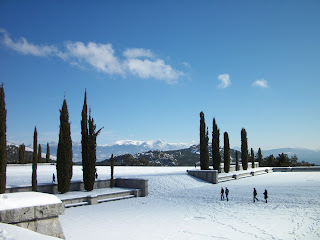This past Sunday, we had our first group trip with Maria Jose. We went to visit the nearby Valley of the Fallen and El Escorial. We left sunny and mild Alcala de Henares to about an hour north of Madrid, in the heart of the “Sierra de Guadarrama,” or the Guadarrama Mountains. This is the largest mountain range of the Iberian Peninsula, the highest peak standing at 7,9600 feet above sea level. Our bus ride was full of twists and turns, crossing under tunnels and winding around the mountains. As our journey took us north, we noticed snow covered landscapes and weather a lot colder than in Alcala.
Our first stop was the Valley of the Fallen, a monumental memorial in the Cuelgamos Valley. This monument was conceived by the dictator Francisco Franco “to honor and bury” those who fell during the civil war, but it was actually a monument to honor and bury Franco. The Valley of the Fallen is a grand and overwhelming monument, which incorporates the unique form of Spanish architecture called Neo-Herrerian, reminiscent of the architect Juan de Herrera, who designed El Escorial. The entire monument consists of an enormous Catholic basilica, a Benedictine Abbey, the Valley, and a towering 500 foot cross standing on the mountain, directly over the main dome of the basilica. The infamous cross is visible from over 20 miles away from the Valley of the Fallen. Franco is buried inside the basilica, right on the altar, opposite of his fallen fellow nationalist, Jose Antonio Primo de Rivera.
Maria Jose shared some of the history of the Valley of the Fallen with us. The design and building of the basilica, Abbey, and cross bean in 1940, soon after the Spanish Civil War had ended. It took 18 long years to complete, mostly through the labor of Republican prisoners. The monument has been controversial since it was built, but it was recently closed in 2009 for “renovations.” Many believe that the Socialist government preferred it closed down. Maria Jose told us that visits are not really allowed, and most people are former Nationalists coming to mass. After doing some research, I found out that many Spaniards see this monument as something similar to a Nazi concentration camp, and do not want it to be a nostalgic place of pilgrimage for Francoists.
After seeing the Valley of the Fallen, we drove about 15 minutes to the town of San Lorenzo de El Escorial. El Escorial was built in the 16th century as a summer palace away from Madrid for King Philip II. The palace is vast and beautiful, also serving as a burial site for most of the Spanish kings of the last five centuries, Bourbons as well as Habsburgs. El Escorial consists of the main palace separated by two successive courtyards and the basilica of San Lorenzo de Real. We had a great tour guide, Fernando, who spoke English and told us lots of fun and interesting facts about El Escorial, such as salacious things about King Philip II and his many girlfriends and that he was about 4’11 in height.
To me, two of the most interesting rooms were the Pantheon of Kings and the Library. The Pantheon of Kings contains twenty-six marble sepulchers with the remains of Kings and Queens. Maria Jose told us that there are two “pudrideros” or rotting rooms at El Escorial that can be visited by the monks of the monastery. The remains of deceased kings are kept here for fifty years, the time necessary for the bodies to fully decompose. The library is a grand room with marble floors, beautifully carved wooden shelves and frescos on the vaulted ceiling. It houses a collection of more than 40,000 volumes.
I really enjoyed seeing The Valley of the Fallen and El Escorial. It was a very interesting, yet fun, group trip. I’m very much looking forward to our next group trips to Toledo and Segovia!
Franco's cross
The majestic Pantheon of Kings
Full view of El Escorial--isn't it massive?!
The back courtyard of El Escorial
The Grand Library







No comments:
Post a Comment